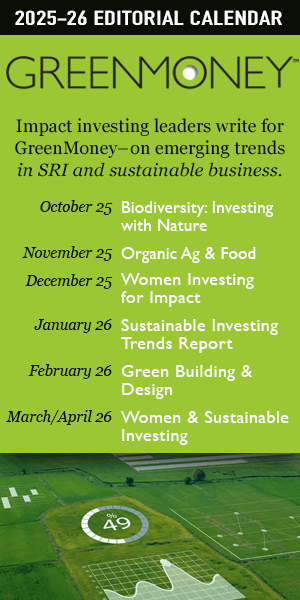Data centers have made significant investments in energy efficiency, but our insatiable appetite for data continues to grow. Renewable energy can reduce our data\’s carbon footprint.
 Buildings consume 40 percent of global energy and create 30 percent of global energy-related greenhouse gas emissions; they are a big part of the climate change puzzle.[1] Energy heats and cools our buildings and it keeps the lights on. Obvious energy reduction strategies are better insulation, LED lighting, and smart thermostats. The energy needs of our data, and the solutions, are less obvious. We’ve moved our music, our movies, and more of our lives into the “cloud”. But our data isn’t actually stored in a cloud. It resides in real buildings we call data centers, which have a large and growing carbon footprint.
Buildings consume 40 percent of global energy and create 30 percent of global energy-related greenhouse gas emissions; they are a big part of the climate change puzzle.[1] Energy heats and cools our buildings and it keeps the lights on. Obvious energy reduction strategies are better insulation, LED lighting, and smart thermostats. The energy needs of our data, and the solutions, are less obvious. We’ve moved our music, our movies, and more of our lives into the “cloud”. But our data isn’t actually stored in a cloud. It resides in real buildings we call data centers, which have a large and growing carbon footprint.
Data centers now use over one percent of global electricity. And because the internet never shuts off, power is required 24 hours a day, seven days a week. Using so much global energy puts a spotlight on what types of energy is being used at technology companies and the data centers that house internet services across the globe.
In 2010, the advocacy organization Greenpeace campaigned for technology companies to use more renewable energy. Their “Clicking Clean” program initially gave many tech firms low scores.[2] Leading brands like Google, Apple, Microsoft, and Salesforce began making commitments to switch to renewables. And data centers, who provide many of the storage, routing, and networking functions for the big tech firms, started figuring out how to give their customers what they want.
The Path to Renewable Energy
Reducing Energy Use Through Efficiency – Ten years ago, data centers consumed 100 to 200 times more energy more than similar sized buildings.[3] Fortunately, companies recognized that “nega-watts”- the electricity they don\’t consume – are both the cleanest and the cheapest energy available. Data centers have made massive gains in efficiency through processor-efficiency improvements and reductions in idle power. These technological advances help servers process 550 percent more data for only six percent more energy.[4] Incremental efficiency improvements can only get us so far when our demands for data continue to grow exponentially. Vert looks for companies that are innovating ways to switch to renewables. Five REITs discussed below are holdings in the Vert Global Sustainable Real Estate Fund: Prologis 4.88 percent, Macerich 0.07 percent, Iron Mountain 1.18 percent, Equinix 4.99 percent and Digital Realty 4.60 percent as of May 31, 2020.

On-Site Renewable Energy Production – Some building types can make excellent use of their large flat roofs to deploy solar panels. Prologis, the world’s largest warehouse REIT (pictured at top), is also one of the largest installers of solar panels. Prologis roof-top solar currently generates 165 Megawatts which is enough to power 24,484 homes for a year.[5] Big box retailers like Walmart and Target have ample roof space and are among the top five producers of roof-top solar energy in the US. Retail real estate, like Macerich REIT who own several sprawling malls in Los Angeles, have deployed large solar arrays on their mall rooftops. But for many other building types this isn’t possible.
Data centers use more energy than is practical to generate onsite. There is no way to fit enough solar panels on the roof to generate enough power to drive all the servers and air conditioners required. Iron Mountain recently installed the largest on-site solar on a datacenter in the US, a 7.2 Megawatt system in Edison, New Jersey. It only powers 15 percent of the building\’s energy needs.[6]
Purchase Renewable Energy – Today, if you want to purchase renewable energy, your options largely depend on who your local utility is. For instance, coal-fired power plants generate 25.4 percent of electricity in Texas, 3.8 percent in Virginia, and only 0.1 percent in California.[7] Renewable energy sources made up 35 percent in California, 16.1 percent in Texas and 8.5 percent in Virginia. If you are in Loudoun County, Virginia, the home to the highest concentration of data centers in the world, you don’t have good options. The local utility provider, Dominion Virginia Power, relies heavily on fossil fuels and has historically been resistant to switch its fuel mix to renewables.
Power Purchase Agreements – Data centers wanting a greener energy profile, but who are stuck with local utilities providing brown energy, need to get creative.
In 2015, Equinix completed a Power Purchase Agreement (PPA) with renewable energy firms NextEra Energy and Invenergy. A PPA is a contract between the buyer and seller of energy for a specific amount of energy at a specific price. By guaranteeing the purchase of 225 Megawatt-hour (MWh), Equinix enabled these providers to complete the build out of their wind farm projects in Oklahoma and Texas.[8] Because the energy from the wind power purchase agreement is generated in the middle of the country where the wind is, not where the data centers use it, a mechanism is needed to ‘transfer’ the renewable energy. This is where Renewable Energy Certificates (RECs – see below) come into play.
Renewable Energy Certificates – Once energy enters into the grid, from any source, it is just energy and we lose track of its origin. A Renewable Energy Certificate or REC is issued for every Megawatt-hour (MWh) of electricity generated and delivered to the grid by a renewable energy source. One MWh is enough to power nearly 1,000 homes for a year. RECs are the currency of the renewable energy market – they allow purchasers to demonstrate demand for renewable energy and provide revenue for it. EPA RECs are uniquely numbered, tracked, and retired: one REC cannot be used by another entity. Anyone can buy RECs – individuals and companies that do so are effectively buying green energy on the grid.
With the virtual PPA in place, Equinix is allocated RECs for all the energy it purchases from NextEra and Invenergy. The company applies these credits towards its overall energy use at its data centers across the US. In this way, Equinix is able to buy 100 percent renewable energy, even if it isn’t locally available at all their sites. The RECs allow Equinix to signal to the market they are a buyer of green energy. And by financing additional wind power to come online via the PPA, Equinix is contributing to the demand for renewable energy and changing the way the cloud is powered.
Multi-Stakeholder Collaboration
Collaboration is critical to greening the grid. Companies like Equinix, Digital Realty and Iron Mountain have played a crucial role as data center leaders in the pursuit of renewable energy. Equinix wanted to help their technology tenants by joining the RE100, an alliance of companies committing to using 100 percent renewables that includes the big tech firms, Google, Apple, and Microsoft. Digital Realty and Iron Mountain collaborated with Facebook and Amazon as part of the Renewable Energy Buyers Alliance (REBA). REBA is organized by four non-profits, including Rocky Mountain Institute, World Resources Institute, World Wildlife Fund and Business for Social Responsibility (BSR). REBA coordinates customers, suppliers, and policymakers to identify barriers to buying clean and renewable energy and develop solutions to meet growing demand.
It is great to see public companies collaborate with their competitors, with their customers, and with non-profits to drive adoption of more renewables. Companies rely on RECs and PPAs because a city, a county, or a state\’s local energy mix is still not green enough. These financial instruments are structured for innovation to circumvent whatever obstacles legacy utility companies have in place. Ultimately, for the grid to get greener, utilities will have to change and for that, new regulation and policy is needed. Investors have a critical voice here. By supporting companies that are committed to renewables, pressuring those that aren’t, and asking more from utilities and regulators, investors can amplify the multi-stakeholder approach to transition to a low carbon economy.
Article by Sam Adams, CEO and co-founder of Vert Asset Management . He also chairs the Investment Research Group. Sam leads the development of new products to help make sustainable investing easier for investors. He has been a featured speaker on sustainable investing at financial advisor conferences in the US, UK, Europe, and Australia. Prior to launching Vert, Sam spent almost 20 years working at Dimensional Fund Advisors. He started Dimensional’s European Financial Advisor Services business and led it for 10 years. Sam was part of the team that created Dimensional’s first ESG strategies, the Sustainability Core funds that are offered in the US. He also led the development and launch of Dimensional’s Global Sustainability Core Fund in Europe.
Sam has a BA in Philosophy from the University of Colorado, Boulder and an MBA in Finance from the University of California, Davis. Sam is an avid mountaineer and cyclist, and is very passionate about the environment. He lives in Mill Valley, CA with his wife and three children.
Footnotes and Sources
[1] United Nations Environmental Programme (2019). The Sustainable Buildings and Paris Agreement (Global Alliance for Buildings and Construction). Retrieved from: https://www.unenvironment.org/news-and-stories/press-release/big-step-ambition-can-open-door-crucial-pollution-cuts-homes-and
[2] Greenpeace (2017). “Clicking Clean: Who is Winning the Race to Build a Green Internet?” Greenpeace, p.5. Accessed at: http://www.clickclean.org/usa/en/
[3] Energy Efficiency and Renewable Energy (March 2011). “Best Practices Guide for Energy-Efficient Data Center Design.” United States Department of Energy, p.1. Accessed at: https://www.energy.gov/sites/prod/files/2013/10/f3/eedatacenterbestpractices.pdf
[4] Masanet, E., et al. (February 28, 2020). “Recalibrating global data center energy-use estimates.” Science, 367(6481), pp. 984-986. Accessed at: https://science.sciencemag.org/content/367/6481/984
[5]. Prologis (2016). “Prologis 2016 Sustainability Report: An Integrated Approach to Sustainability,” p. 16.
[6] Iron Mountain (2019). “Iron Mountain Announces the Largest Rooftop Solar Installation of Any Data Center in The US.” Accessed at: https://www.ironmountain.com/about-us/news-events/news-categories/press-releases/2019/october/iron-mountain-announces-the-largest-rooftop-solar-installation-of-any-data-center-in-the-us
[7] US Energy Information and Administration (various dates 2016-2018). “State Profile and Energy Estimates.” EIA. Accessed at:
https://www.eia.gov/state/compare/?sid=VA#?selected=US-CA-TX-VA-WV
[8] Equinix (2015). “Equinix Signs Power Purchase Agreements that Bring its North American Data Centers to 100 percent Renewable Energy.” Newsroom, Equinix. Accessed at: https://www.equinix.com/newsroom/press-releases/pr/123421/equinix-signs-power-purchase-agreements-that-bring-its-north-american-data-centers-to-100-renewable-energy/
The Vert Global Sustainable Real Estate Fund only holds publicly traded REITs. The Fund does not hold other types of public companies including Google, Apple, Microsoft, Salesforce. The Fund does not invest in non-profit organizations including Greenpeace, Rocky Mountain Institute, World Resources Institute, World Wildlife Fund and Business for Social Responsibility. The Fund does not invest in energy companies including NextEra or Invenergy. Fund holdings and sectors are subject to change at any time and should not be considered a recommendation to buy or sell any security.
Mutual fund investments involve risk. Principal loss is possible. Investors should be aware of the risks involved with investing in a fund concentrating in REITs and real estate securities, such as declines in the value of real estate and increased susceptibility to adverse economic or regulatory developments. Investments in foreign securities involve political, economic and currency risks, greater volatility and differences in accounting methods. A REIT’s share price may decline because of adverse developments affecting the real estate industry. REITs may be subject to special tax rules and may not qualify for favorable federal tax treatment which could have adverse tax consequences. The Fund’s focus on sustainability may limit the number of investment opportunities available to the fund and at time the fund may underperform funds that are not subject to similar investment considerations.
The Vert Global Sustainable Real Estate Fund\’s investment objectives, risks, charges, and expenses must be considered carefully before investing. The statutory and summary prospectuses contain this and other important information about the investment company, and may be obtained by calling 1-844-740-VERT or visiting www.vertfunds.com . Read carefully before investing.
The Vert Global Sustainable Real Estate Fund is distributed by Quasar Distributors, LLC.


















